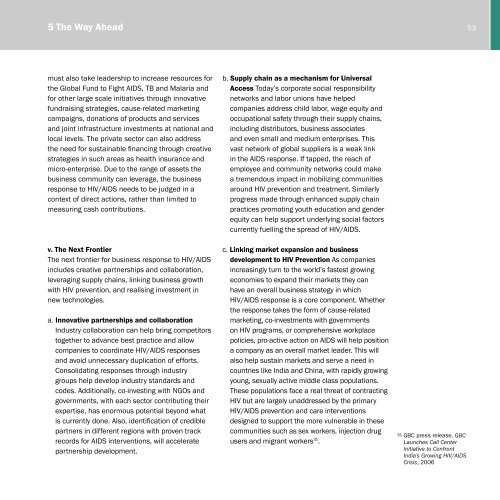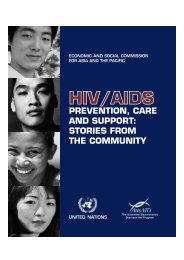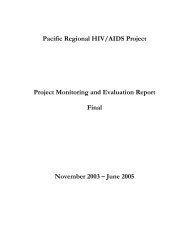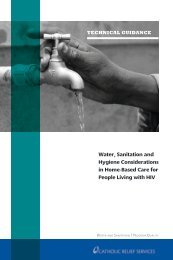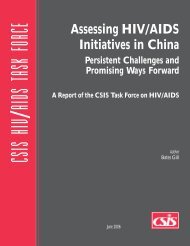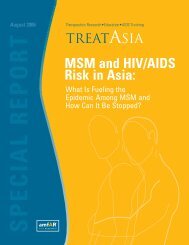The State of Business and HIV/AIDS (2006) - Booz Allen Hamilton
The State of Business and HIV/AIDS (2006) - Booz Allen Hamilton
The State of Business and HIV/AIDS (2006) - Booz Allen Hamilton
You also want an ePaper? Increase the reach of your titles
YUMPU automatically turns print PDFs into web optimized ePapers that Google loves.
5 <strong>The</strong> Way Ahead<br />
53<br />
must also take leadership to increase resources for<br />
the Global Fund to Fight <strong>AIDS</strong>, TB <strong>and</strong> Malaria <strong>and</strong><br />
for other large scale initiatives through innovative<br />
fundraising strategies, cause-related marketing<br />
campaigns, donations <strong>of</strong> products <strong>and</strong> services<br />
<strong>and</strong> joint infrastructure investments at national <strong>and</strong><br />
local levels. <strong>The</strong> private sector can also address<br />
the need for sustainable financing through creative<br />
strategies in such areas as health insurance <strong>and</strong><br />
micro-enterprise. Due to the range <strong>of</strong> assets the<br />
business community can leverage, the business<br />
response to <strong>HIV</strong>/<strong>AIDS</strong> needs to be judged in a<br />
context <strong>of</strong> direct actions, rather than limited to<br />
measuring cash contributions.<br />
v. <strong>The</strong> Next Frontier<br />
<strong>The</strong> next frontier for business response to <strong>HIV</strong>/<strong>AIDS</strong><br />
includes creative partnerships <strong>and</strong> collaboration,<br />
leveraging supply chains, linking business growth<br />
with <strong>HIV</strong> prevention, <strong>and</strong> realising investment in<br />
new technologies.<br />
a. Innovative partnerships <strong>and</strong> collaboration<br />
Industry collaboration can help bring competitors<br />
together to advance best practice <strong>and</strong> allow<br />
companies to coordinate <strong>HIV</strong>/<strong>AIDS</strong> responses<br />
<strong>and</strong> avoid unnecessary duplication <strong>of</strong> efforts.<br />
Consolidating responses through industry<br />
groups help develop industry st<strong>and</strong>ards <strong>and</strong><br />
codes. Additionally, co-investing with NGOs <strong>and</strong><br />
governments, with each sector contributing their<br />
expertise, has enormous potential beyond what<br />
is currently done. Also, identification <strong>of</strong> credible<br />
partners in different regions with proven track<br />
records for <strong>AIDS</strong> interventions, will accelerate<br />
partnership development.<br />
b. Supply chain as a mechanism for Universal<br />
Access Today’s corporate social responsibility<br />
networks <strong>and</strong> labor unions have helped<br />
companies address child labor, wage equity <strong>and</strong><br />
occupational safety through their supply chains,<br />
including distributors, business associates<br />
<strong>and</strong> even small <strong>and</strong> medium enterprises. This<br />
vast network <strong>of</strong> global suppliers is a weak link<br />
in the <strong>AIDS</strong> response. If tapped, the reach <strong>of</strong><br />
employee <strong>and</strong> community networks could make<br />
a tremendous impact in mobilizing communities<br />
around <strong>HIV</strong> prevention <strong>and</strong> treatment. Similarly<br />
progress made through enhanced supply chain<br />
practices promoting youth education <strong>and</strong> gender<br />
equity can help support underlying social factors<br />
currently fuelling the spread <strong>of</strong> <strong>HIV</strong>/<strong>AIDS</strong>.<br />
c. Linking market expansion <strong>and</strong> business<br />
development to <strong>HIV</strong> Prevention As companies<br />
increasingly turn to the world’s fastest growing<br />
economies to exp<strong>and</strong> their markets they can<br />
have an overall business strategy in which<br />
<strong>HIV</strong>/<strong>AIDS</strong> response is a core component. Whether<br />
the response takes the form <strong>of</strong> cause-related<br />
marketing, co-investments with governments<br />
on <strong>HIV</strong> programs, or comprehensive workplace<br />
policies, pro-active action on <strong>AIDS</strong> will help position<br />
a company as an overall market leader. This will<br />
also help sustain markets <strong>and</strong> serve a need in<br />
countries like India <strong>and</strong> China, with rapidly growing<br />
young, sexually active middle class populations.<br />
<strong>The</strong>se populations face a real threat <strong>of</strong> contracting<br />
<strong>HIV</strong> but are largely unaddressed by the primary<br />
<strong>HIV</strong>/<strong>AIDS</strong> prevention <strong>and</strong> care interventions<br />
designed to support the more vulnerable in these<br />
communities such as sex workers, injection drug<br />
users <strong>and</strong> migrant workers 31 .<br />
31 GBC press release, GBC<br />
Launches Call Center<br />
Initiative to Confront<br />
India’s Growing <strong>HIV</strong>/<strong>AIDS</strong><br />
Crisis, <strong>2006</strong>


